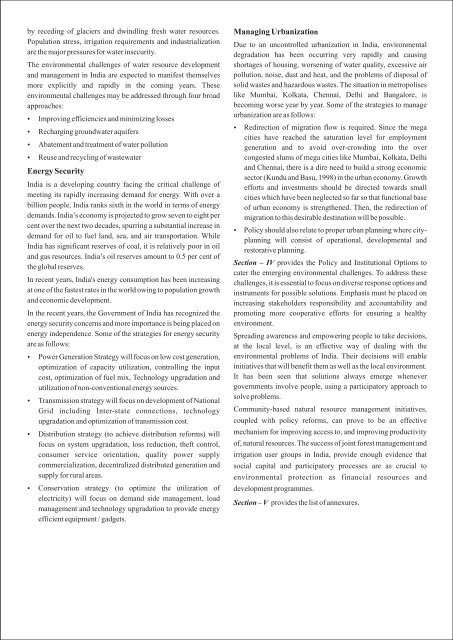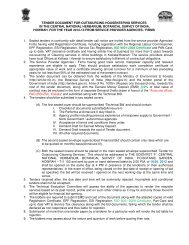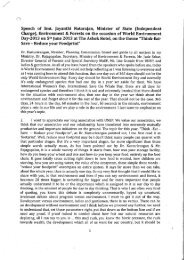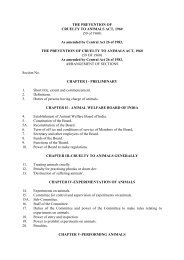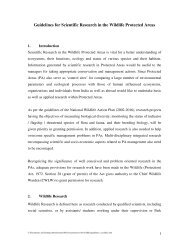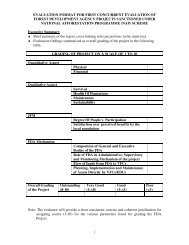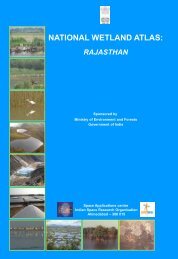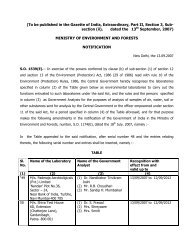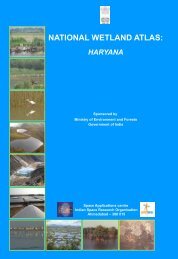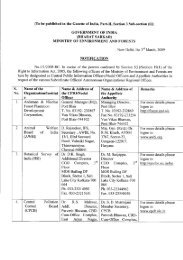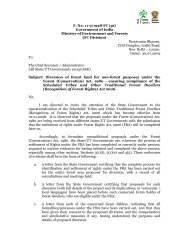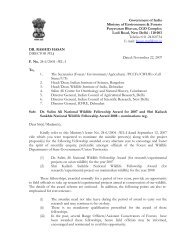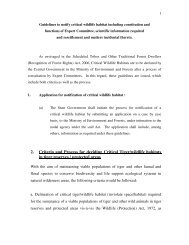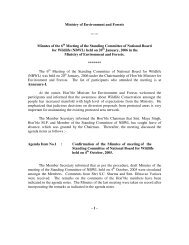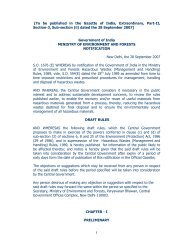lR;eso t;rs - Ministry of Environment and Forests
lR;eso t;rs - Ministry of Environment and Forests
lR;eso t;rs - Ministry of Environment and Forests
You also want an ePaper? Increase the reach of your titles
YUMPU automatically turns print PDFs into web optimized ePapers that Google loves.
y receding <strong>of</strong> glacie<strong>rs</strong> <strong>and</strong> dwindling fresh water r<strong>eso</strong>urces.<br />
Population stress, irrigation requirements <strong>and</strong> industrialization<br />
are the major pressures for water insecurity.<br />
The environmental challenges <strong>of</strong> water r<strong>eso</strong>urce development<br />
<strong>and</strong> management in India are expected to manifest themselves<br />
more explicitly <strong>and</strong> rapidly in the coming yea<strong>rs</strong>. These<br />
environmental challenges may be addressed through four broad<br />
approaches:<br />
�Improving efficiencies <strong>and</strong> minimizing losses<br />
�Recharging groundwater aquife<strong>rs</strong><br />
�Abatement <strong>and</strong> treatment <strong>of</strong> water pollution<br />
�Reuse <strong>and</strong> recycling <strong>of</strong> wastewater<br />
Energy Security<br />
India is a developing country facing the critical challenge <strong>of</strong><br />
meeting its rapidly increasing dem<strong>and</strong> for energy. With over a<br />
billion people, India ranks sixth in the world in terms <strong>of</strong> energy<br />
dem<strong>and</strong>s. India’s economy is projected to grow seven to eight per<br />
cent over the next two decades, spurring a substantial increase in<br />
dem<strong>and</strong> for oil to fuel l<strong>and</strong>, sea, <strong>and</strong> air transportation. While<br />
India has significant reserves <strong>of</strong> coal, it is relatively poor in oil<br />
<strong>and</strong> gas r<strong>eso</strong>urces. India’s oil reserves amount to 0.5 per cent <strong>of</strong><br />
the global reserves.<br />
In recent yea<strong>rs</strong>, India's energy consumption has been increasing<br />
at one <strong>of</strong> the fastest rates in the world owing to population growth<br />
<strong>and</strong> economic development.<br />
In the recent yea<strong>rs</strong>, the Government <strong>of</strong> India has recognized the<br />
energy security concerns <strong>and</strong> more importance is being placed on<br />
energy independence. Some <strong>of</strong> the strategies for energy security<br />
are as follows:<br />
�Power Generation Strategy will focus on low cost generation,<br />
optimization <strong>of</strong> capacity utilization, controlling the input<br />
cost, optimization <strong>of</strong> fuel mix, Technology upgradation <strong>and</strong><br />
utilization <strong>of</strong> non-conventional energy sources.<br />
�Transmission strategy will focus on development <strong>of</strong> National<br />
Grid including Inter-state connections, technology<br />
upgradation <strong>and</strong> optimization <strong>of</strong> transmission cost.<br />
�Distribution strategy (to achieve distribution reforms) will<br />
focus on system upgradation, loss reduction, theft control,<br />
consumer service orientation, quality power supply<br />
commercialization, decentralized distributed generation <strong>and</strong><br />
supply for rural areas.<br />
�Conservation strategy (to optimize the utilization <strong>of</strong><br />
electricity) will focus on dem<strong>and</strong> side management, load<br />
management <strong>and</strong> technology upgradation to provide energy<br />
efficient equipment / gadgets.<br />
Managing Urbanization<br />
Due to an uncontrolled urbanization in India, environmental<br />
degradation has been occurring very rapidly <strong>and</strong> causing<br />
shortages <strong>of</strong> housing, wo<strong>rs</strong>ening <strong>of</strong> water quality, excessive air<br />
pollution, noise, dust <strong>and</strong> heat, <strong>and</strong> the problems <strong>of</strong> disposal <strong>of</strong><br />
solid wastes <strong>and</strong> hazardous wastes. The situation in metropolises<br />
like Mumbai, Kolkata, Chennai, Delhi <strong>and</strong> Bangalore, is<br />
becoming wo<strong>rs</strong>e year by year. Some <strong>of</strong> the strategies to manage<br />
urbanization are as follows:<br />
�Redirection <strong>of</strong> migration flow is required. Since the mega<br />
cities have reached the saturation level for employment<br />
generation <strong>and</strong> to avoid over-crowding into the over<br />
congested slums <strong>of</strong> mega cities like Mumbai, Kolkata, Delhi<br />
<strong>and</strong> Chennai, there is a dire need to build a strong economic<br />
sector (Kundu <strong>and</strong> Basu, 1998) in the urban economy. Growth<br />
efforts <strong>and</strong> investments should be directed towards small<br />
cities which have been neglected so far so that functional base<br />
<strong>of</strong> urban economy is strengthened. Then, the redirection <strong>of</strong><br />
migration to this desirable destination will be possible.<br />
�Policy should also relate to proper urban planning where cityplanning<br />
will consist <strong>of</strong> operational, developmental <strong>and</strong><br />
restorative planning.<br />
Section – IV provides the Policy <strong>and</strong> Institutional Options to<br />
cater the emerging environmental challenges. To address these<br />
challenges, it is essential to focus on dive<strong>rs</strong>e response options <strong>and</strong><br />
instruments for possible solutions. Emphasis must be placed on<br />
increasing stakeholde<strong>rs</strong> responsibility <strong>and</strong> accountability <strong>and</strong><br />
promoting more cooperative efforts for ensuring a healthy<br />
environment.<br />
Spreading awareness <strong>and</strong> empowering people to take decisions,<br />
at the local level, is an effective way <strong>of</strong> dealing with the<br />
environmental problems <strong>of</strong> India. Their decisions will enable<br />
initiatives that will benefit them as well as the local environment.<br />
It has been seen that solutions always emerge whenever<br />
governments involve people, using a participatory approach to<br />
solve problems.<br />
Community-based natural r<strong>eso</strong>urce management initiatives,<br />
coupled with policy reforms, can prove to be an effective<br />
mechanism for improving access to, <strong>and</strong> improving productivity<br />
<strong>of</strong>, natural r<strong>eso</strong>urces. The success <strong>of</strong> joint forest management <strong>and</strong><br />
irrigation user groups in India, provide enough evidence that<br />
social capital <strong>and</strong> participatory processes are as crucial to<br />
environmental protection as financial r<strong>eso</strong>urces <strong>and</strong><br />
development programmes.<br />
Section – V provides the list <strong>of</strong> annexures.


